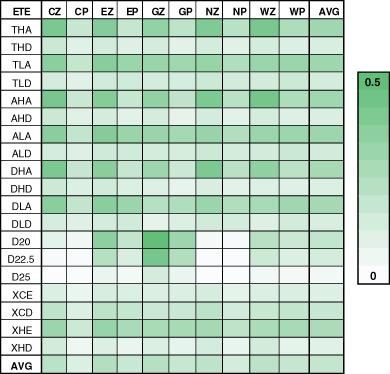当前位置:
X-MOL 学术
›
Int. J. Climatol.
›
论文详情
Our official English website, www.x-mol.net, welcomes your
feedback! (Note: you will need to create a separate account there.)
The relationship between atmospheric circulation patterns and extreme temperature events in North America
International Journal of Climatology ( IF 3.5 ) Pub Date : 2020-04-18 , DOI: 10.1002/joc.6610 Ryan E. Adams 1 , Cameron C. Lee 1 , Erik T. Smith 1 , Scott C. Sheridan 1
International Journal of Climatology ( IF 3.5 ) Pub Date : 2020-04-18 , DOI: 10.1002/joc.6610 Ryan E. Adams 1 , Cameron C. Lee 1 , Erik T. Smith 1 , Scott C. Sheridan 1
Affiliation

|
Extreme temperature events (ETEs) pose a significant risk to society, especially vulnerable populations with limited access to shelter and water and those with pre‐existing respiratory and cardiovascular ailments. This research examines the relationship of atmospheric circulation with a myriad of metrics related to ETEs to better understand which synoptic‐scale circulations are likely to have negative health/thermal comfort outcomes. Daily sea‐level pressure (SLP) and 500‐hPa geopotential height (z500) data from the North American Regional Reanalysis (NARR) were used to identify circulation patterns over North America. Self‐organizing maps were used to partition the variability in circulation patterns over five distinct domains covering North America for both variables. Daily 2‐m temperature, 2‐m dewpoint temperature, and 10‐m wind data from the NARR were used to derive five major categories of ETEs based on 95th percentiles: temperature events, apparent temperature events, dew point events, and excess heat and excess cold temperature events. The relationship of circulation pattern frequencies (SOM nodes) leading up to ETEs were assessed using point biserial correlations, accounting for spatial and temporal autocorrelation. The results show that z500 has a stronger association with ETEs than does SLP. A great deal of spatial variability exists in the strength of relationship for many ETE variables with circulation patterns likely due to the local geographical influence (e.g., leeside mountain adiabatic warming and low‐level maritime flow). Generally, high extremes are associated with broad ridging and anticyclonic flow and cold extremes are associated with high amplitude trough patterns with low‐level flow originating from the continental interior. The use of self‐organizing maps presents a unique way of examining the potential for human health risks related ETEs and may be an effective method for statistically downscaling climate model data to assess the potential for ETEs in the future.
中文翻译:

北美大气环流模式与极端温度事件之间的关系
极端温度事件(ETE)对社会构成重大风险,尤其是难以获得庇护所和水的脆弱人群以及先前患有呼吸道和心血管疾病的人群。这项研究检查了大气环流与与ETE相关的大量指标之间的关系,以更好地了解哪些天气尺度环流可能对健康/热舒适性产生负面影响。来自北美区域再分析(NARR)的每日海平面压力(SLP)和500-hPa地势高度(z500)数据用于识别北美的环流模式。自组织图用于在两个变量的覆盖北美的五个不同区域上划分循环模式的可变性。每天2米的温度,2米的露点温度,根据第95个百分位数,使用NARR的10 m风数据推导出五类主要ETE:温度事件,表观温度事件,露点事件以及过热和过冷温度事件。使用点二元相关性评估了导致ETE的循环模式频率(SOM节点)之间的关系,并考虑了空间和时间的自相关性。结果表明,z500与ETE的关联性比SLP强。许多ETE变量与循环模式的关系强度存在很大的空间变异性,这可能是由于当地地理因素(例如,背风山绝热变暖和海平面低潮)引起的。通常,高的极端与宽泛的褶皱和反气旋流动有关,而冷的极端与高振幅的槽型有关,低水平的流动源于大陆内部。自组织图的使用提供了一种独特的方式来检查与人类健康风险相关的ETE的潜力,并且可能是统计缩减气候模型数据以评估未来ETE潜力的有效方法。
更新日期:2020-04-18
中文翻译:

北美大气环流模式与极端温度事件之间的关系
极端温度事件(ETE)对社会构成重大风险,尤其是难以获得庇护所和水的脆弱人群以及先前患有呼吸道和心血管疾病的人群。这项研究检查了大气环流与与ETE相关的大量指标之间的关系,以更好地了解哪些天气尺度环流可能对健康/热舒适性产生负面影响。来自北美区域再分析(NARR)的每日海平面压力(SLP)和500-hPa地势高度(z500)数据用于识别北美的环流模式。自组织图用于在两个变量的覆盖北美的五个不同区域上划分循环模式的可变性。每天2米的温度,2米的露点温度,根据第95个百分位数,使用NARR的10 m风数据推导出五类主要ETE:温度事件,表观温度事件,露点事件以及过热和过冷温度事件。使用点二元相关性评估了导致ETE的循环模式频率(SOM节点)之间的关系,并考虑了空间和时间的自相关性。结果表明,z500与ETE的关联性比SLP强。许多ETE变量与循环模式的关系强度存在很大的空间变异性,这可能是由于当地地理因素(例如,背风山绝热变暖和海平面低潮)引起的。通常,高的极端与宽泛的褶皱和反气旋流动有关,而冷的极端与高振幅的槽型有关,低水平的流动源于大陆内部。自组织图的使用提供了一种独特的方式来检查与人类健康风险相关的ETE的潜力,并且可能是统计缩减气候模型数据以评估未来ETE潜力的有效方法。











































 京公网安备 11010802027423号
京公网安备 11010802027423号